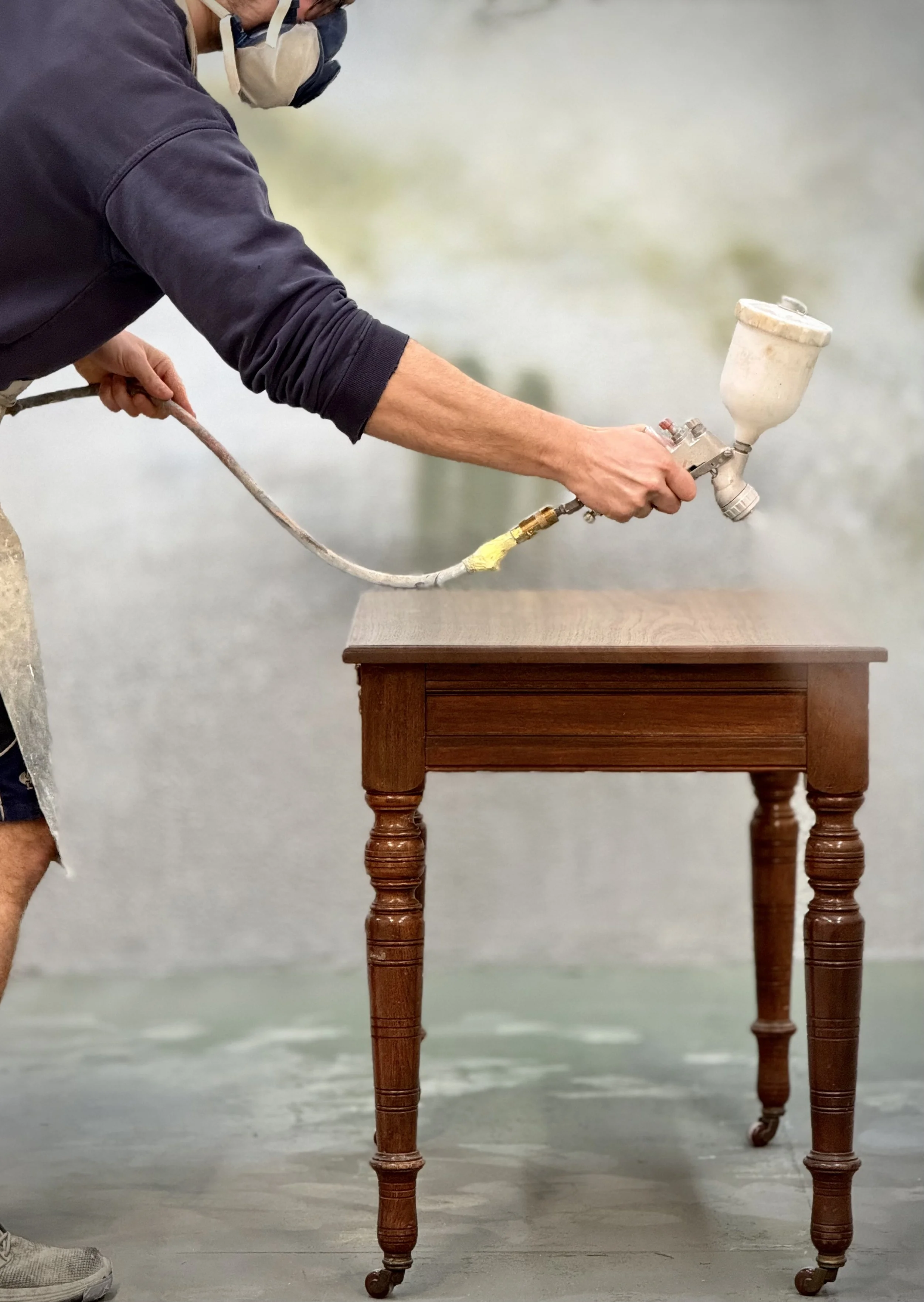27 July
The Power of Spray Finishing: When Precision Meets Speed
In the world of wood finishing, there’s no one-size-fits-all approach. While traditional hand polishing has its timeless appeal, spray finishing has earned its place in the workshop — especially for larger surfaces or modern furniture.
Whether you’re restoring a tabletop or refinishing an entire cabinet suite, spray finishing offers a smooth, even coat that’s hard to beat for speed and consistency.
What Is Spray Finishing?
Spray finishing involves applying a finish — like lacquer, polyurethane, or water-based coatings — using a spray gun connected to a compressor. This method atomizes the finish into a fine mist, allowing it to settle evenly onto the surface.
Compared to brushes or cloths, spraying is much faster and can produce a professional-grade finish with minimal texture — often referred to as a “glass-like” or “factory finish.”
When Spray Finishing Makes Sense
Spray finishing is especially useful in the following situations:
• Large flat surfaces like dining tables, cabinet doors, or modern furniture
• High-production settings where time and efficiency matter
• Modern pieces where a slick, flawless finish is expected
• Complex shapes where brush marks would be hard to avoid
Advantages of Spray Finishing
• Speed: Covers large surfaces quickly
• Consistency: Achieves an even coat with no brush strokes
• Control: Adjust flow, fan pattern, and pressure for different materials
• Versatility: Can spray a wide range of different finnishes
The Importance of Preparation
Like any finishing method, the quality of the spray job depends on preparation. We always make sure:
• The surface is properly sanded and clean
• Dust is controlled to avoid imperfections
• The finish is strained before spraying
• The workspace is well-ventilated and protected
A great finish doesn’t just come from the spray gun — it comes from the care taken beforehand.
Spray Finishing vs Hand Polishing: What’s the Difference?
While spray finishing excels at speed and smoothness, hand polishing offers depth, warmth, and repairability — especially on antique or high-end furniture.
Each method has its place — and the real skill lies in knowing which to use, and when.
27 July
The Power of Spray Finishing: When Precision Meets Speed
In the world of wood finishing, there’s no one-size-fits-all approach. While traditional hand polishing has its timeless appeal, spray finishing has earned its place in the workshop — especially for larger surfaces or modern furniture.
Whether you’re restoring a tabletop or refinishing an entire cabinet suite, spray finishing offers a smooth, even coat that’s hard to beat for speed and consistency.
What Is Spray Finishing?
Spray finishing involves applying a finish — like lacquer, polyurethane, or water-based coatings — using a spray gun connected to a compressor. This method atomizes the finish into a fine mist, allowing it to settle evenly onto the surface.
Compared to brushes or cloths, spraying is much faster and can produce a professional-grade finish with minimal texture — often referred to as a “glass-like” or “factory finish.”
When Spray Finishing Makes Sense
Spray finishing is especially useful in the following situations:
• Large flat surfaces like dining tables, cabinet doors, or modern furniture
• High-production settings where time and efficiency matter
• Modern pieces where a slick, flawless finish is expected
• Complex shapes where brush marks would be hard to avoid
Advantages of Spray Finishing
• Speed: Covers large surfaces quickly
• Consistency: Achieves an even coat with no brush strokes
• Control: Adjust flow, fan pattern, and pressure for different materials
• Versatility: Can spray a wide range of different finnishes
The Importance of Preparation
Like any finishing method, the quality of the spray job depends on preparation. We always make sure:
• The surface is properly sanded and clean
• Dust is controlled to avoid imperfections
• The finish is strained before spraying
• The workspace is well-ventilated and protected
A great finish doesn’t just come from the spray gun — it comes from the care taken beforehand.
Spray Finishing vs Hand Polishing: What’s the Difference?
While spray finishing excels at speed and smoothness, hand polishing offers depth, warmth, and repairability — especially on antique or high-end furniture.
Each method has its place — and the real skill lies in knowing which to use, and when.

